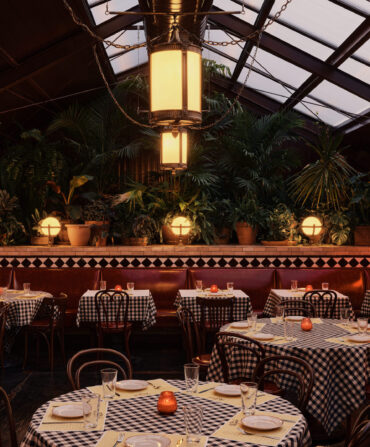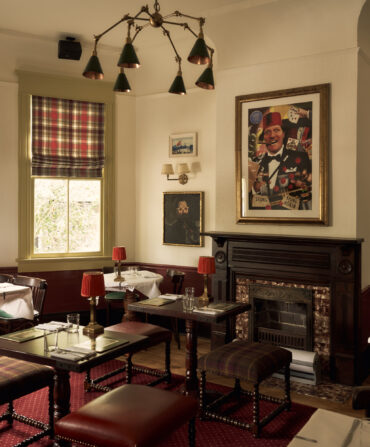Food & Drink
Mashama Bailey’s Home Cooking
Savannah has never been at the red-hot center of the culinary universe, but with serious chops, plenty of moxie, and one of the country’s hottest new restaurants, Chef Bailey is changing that—and proving that sometimes you actually can go home again
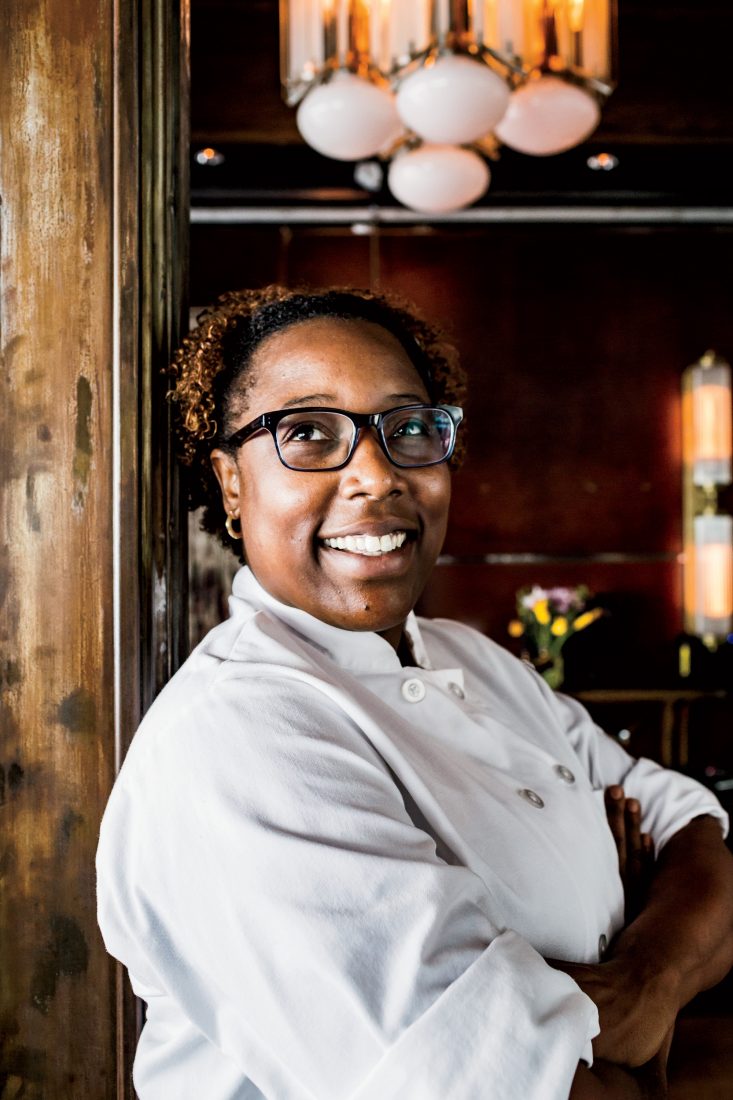
Peter Frank Edwards
The steam is sheet-thick behind the grill where Chef Mashama Bailey is cooking for what she calls the Yard, a low-key picnic-style luncheon she and her business partner, Johno Morisano, host every Saturday in the outdoor space flanking their splashy, year-old Savannah restaurant, the Grey. The Yard is open to the public and serves whatever Bailey feels inspired to prepare for seven dollars flat.
“It’s community outreach,” Morisano, also grill-side, explains, running a damp towel over his forehead before tossing it back across one shoulder. “We never make money from it. People can be intimidated by the restaurant, so we do a version of the menu that is more approachable.”
Today “approachable” means Italian sausages coiled like garden hoses, wriggling and spitting over an open flame. Beside them, halved tomatoes char, their skin puckering to a deep sweetness. Also, vegetables. (And because this is the South, a full bar, for those with more cash to spend.)
Damp with sweat, Bailey, who is forty-one, minds the food and the scene as she gulps ice water from a plastic container. She’s dressed in a navy T-shirt and a white apron, her hair pulled tight and tucked under a baseball cap that reads GEORGIA ORGANICS. She flips the meat, then ducks into the restaurant, emerging moments later carrying three more containers of ice water, which she hand delivers to Morisano and various staffers.
Morisano drinks eagerly, nodding in Bailey’s direction.
“She does everything,” he says with a measure of awe. “She doesn’t even have a proper sous-chef yet. Who knows what she’ll be able to accomplish once she can concentrate on just being in charge.”
Later in the day as lunch winds down, Bailey explains that being in charge is not something that comes naturally to her.
“I like being in the background,” she says, cocking her head slightly. “Cooking is the way I stand out. My whole life, it’s been a way to get positive feedback without being, like, ‘Heyyyyy!’”
Recruited by Morisano from New York’s fabled Prune restaurant, Bailey has been awash in praise since she relocated from Queens to her former hometown of Savannah and set about ushering the Grey into a place of culinary prominence before its first birthday.
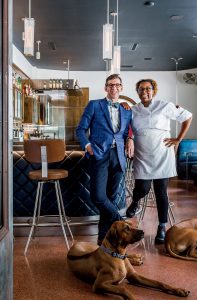
Peter Frank Edwards
Bailey and her business partner, Johno Morisano.
“There is sophistication here,” Morisano insists of a town hitherto disregarded by gastronomes. “The people I know living in Savannah are clamoring for this type of food. Why can’t we compete with New York and Atlanta? There is no reason we can’t be a part of that bigger conversation.” That said, when the celebrated restaurateur Hugh Acheson recently opened the Florence (his own foray into elevated Savannah dining), “I let out a sigh of relief,” Morisano admits. “It was like, yes! I’m not insane.”
Unequivocally heralded as one of the best new restaurants in America—possibly even the best—the Grey is the rare darling that doesn’t disappoint, managing to radiate a lived-in excellence that takes most eateries years to achieve.
Some of this is owed to the location. Situated in a gloriously renovated 1938 Greyhound bus station, the Grey came with history attached. Much was good—the sexy deco architecture, the unusual but surprisingly commodious footprint, the charming stylistic particulars of bygone travel no one much bothers with anymore. But there was also the enervating baggage of the building’s Southern past, the terminal constructed with separate waiting rooms and lavatories for African American and white travelers. In a profession where women at the top are few, and women of color in the same position rarer still, Bailey’s dominance and elevation of modern fine dining from a restaurant housed in a formerly segregated bus depot is not just a staggering juxtaposition of past and future, but also a testament to a woman (modest or not) with brass to spare.
And so it is with her food. Just as she and Morisano have taken a utilitarian space that was never intended to be spectacular or captivating and made it both, Bailey has reached for ingredients and dishes that begin in the Southern vernacular—pulled pork, collards, boudin—and burnished them into something even better.
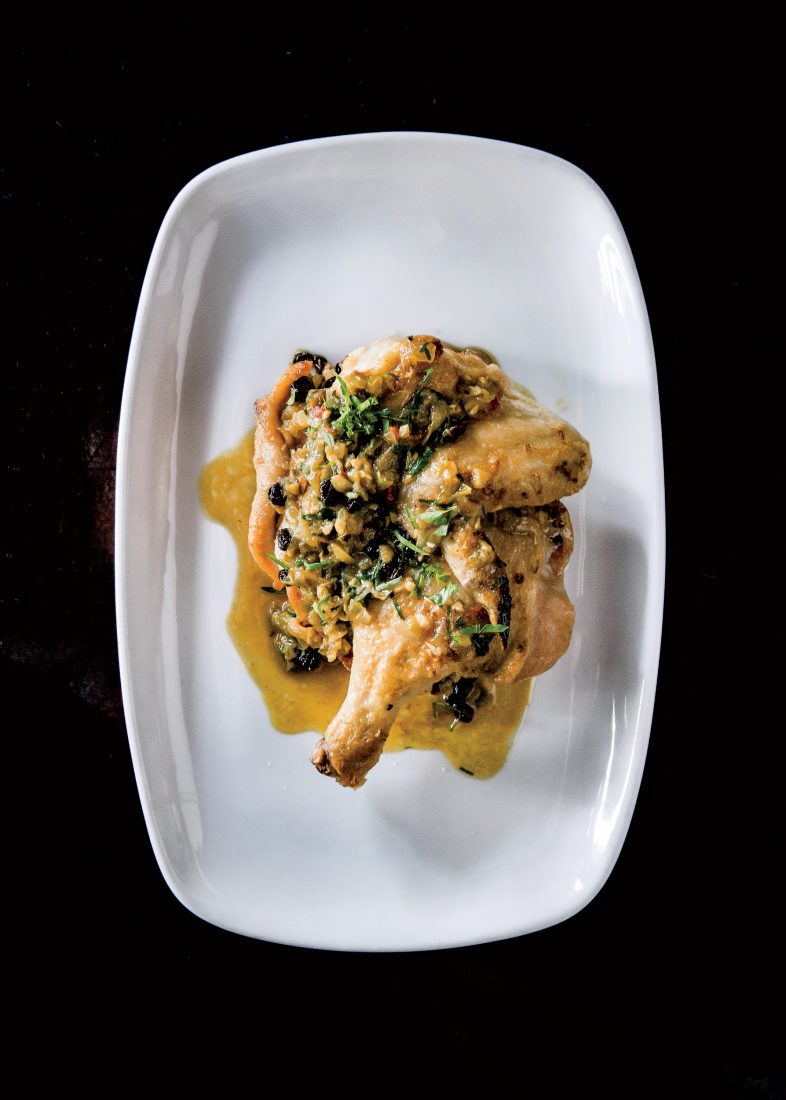
Peter Frank Edwards
Bailey’s take on Country Captain.
Dumplings are steamed with brothy clams. Pork sizzles in a skillet with an egg nestled amid the tissue-tender meat. Sweetened fried rolls leavened with potato perch on the side like heaven’s doughnut holes. As a palate cleanser, Bailey serves “Thrills,” a nod to the Daffin Park neighborhood of her childhood, where locals would freeze sugar and juice in paper cups as a treat to cool off the kids. Bailey’s pops are derived from muscadine, and yet the effect mirrors the original. They remain fun, nostalgic, a tether of memory yanking at the heart and tongue.
Such is Bailey’s signature. She delivers surprise in the everyday, a note of difference that wakes people up. She takes what’s familiar and transforms it into something seductive, like seeing your spouse with a flattering new haircut, reminding you why you fell in love in the first place.
“I have all this training,” she says of her style. “Mostly French, and then all these influences, Spanish, Italian. Plus I have my mother, my grandmothers, and that’s the food I crave. Vinegary cucumber salad with white onion and a ton of black pepper, fried chicken, Brunswick stew. The food I grew up on. Right now, my food is being shaped by being in Savannah. When I first got here, I was like, I wonder if I can cook with the Spanish moss? I wonder what’s here that people aren’t tapping into?”
Bailey isn’t a fan of categories or boxes or being put into them. She prefers to respond to where she is, geographically, psychologically, emotionally.
“Coming down here to do the Grey, people kept asking, ‘What sort of restaurant is it going to be?’ And I was, uhhhh…blank. I didn’t know the answer. It was almost a little embarrassing for Johno. So I would say, ‘It’s Southern, European, French, this, that’—all these words. I’d say everything. But really, it’s just good.”
It is the morning after the yard picnic, and Bailey is ordering an almond milk smoothie at the café near her rental apartment off of Forsyth Park when she confesses she was certain she’d blown her initial audition for Morisano.
“He and his wife, Carol, came to Prune and sat at the bar. I sent them a variety of dishes, sweetbreads, branzino, but the two plates I did especially for them, they hated. One was a crab leg in a bowl, and they were not into it.”
Morisano gave Bailey another shot and scheduled a tasting dinner at his house for select family and guests. Bailey asked her brother to join for moral support and encouraged him to bring a friend. He invited a vegan.
“I was like, what? Really?” Bailey recalls, laughing. She was already nervous, but she tweaked her menu, “put it all out there on the plate,” and after a service of pan-seared trout, collard greens, pickled shrimp, chicken liver mousse, pimento cheese, chicken schnitzel with white barbecue sauce, and many, many other dishes, Morisano was convinced. Mostly.
“He gave me an A-minus,” Bailey recalls, raising her eyebrows. “And I asked, ‘Well, do I have the job?’ And he said right then and there, ‘It isn’t a job, it’s a partnership.’ Which is when it got scary. This wasn’t something I could just walk away from. It was a real proposal, a real future.”
In some ways, moving back south was the “big hurdle” for Bailey. She adored New York, and the cultural freedoms it provided. She’d also been living with her paternal grandmother, acting as her caretaker and conduit to the larger world. “When I decided to move, she was the hardest person to tell.”
Ironically, it was her grandmother who’d introduced Bailey, as a girl, to new ways of thinking about eating. Margaret Bailey had been born in Forsyth, Georgia, and moved to Queens. Bailey’s great-grandmother found work in Manhattan as a maid for the Honeymooners actor Art Carney and his family, a position that exposed her to “wealth and fine food,” Bailey says. “My grandmother became a nurse and a caretaker who worked for rich families too,” she continues. “And so she always had this elitism about food. It was a sign of success to her. It gave her great pleasure to have the best ingredients she could afford.”
Bailey recalls her grandmother executing complicated recipes from Joy of Cooking. Margaret also took Bailey on her first visit to the legendary deli Zabar’s. “I had to be twelve at the time.” The day was sunny and hot, the streets reeking of baked asphalt and spent cigarettes. Her grandmother snagged a parking spot right in front of the shop, and as they exited the car and pushed through the doors, Bailey remembers feeling gobsmacked by the sight of food hanging from the ceilings, the scent of yeast, the metallic bite of pickles and fermented fish that settled on her tongue like a snowflake.
“It was no Piggly Wiggly,” she says, laughing. “I’d never been exposed to anything like it. And the food was expensive.” But her grandmother bought it anyway, and they lugged the bags home, where they sat around the table eating bagels and cream cheese and seafood salad and lamb chops, and Bailey, not realizing it then, felt the stirrings of what would become her life’s work.
“If I had stayed in Georgia, I wouldn’t be the chef I am,” she observes. “My grandmother’s influence was so critical. She broadened my horizons even about spending money on food. She taught me food was worth it.”
Bailey’s palate expanded even further after she attended Sullivan County Community College in Upstate New York. The student body was heavily international, and everyone shared housing, where you needed to cook for yourself. “That’s when I really started experimenting. I always cooked for my brother and sister, but it was cheese steaks or pizza on an English muffin. When I came home from college, all of a sudden I was making roti and curry chicken. I was cooking. And I remember my mother tried a dish and said, ‘You know what? You’re really good. You should go into this business.’ And I immediately shook my head and said, ‘No way, it’s too much work. Who wants to do that?’”
Following college, Bailey pursued a career in social services, but her infatuation with food persisted. “A big part of me wants to please people, to make them feel good,” she says. “That aspect of cooking always appealed to my personality.”
After a series of social-work jobs, she bit the spatula and applied for culinary school. She excelled there and in the positions that followed, none more so than the one at Prune. “My grandmother thought working at Prune was crazy,” says Bailey, who regularly logged shifts that saw her getting home after 2:30 a.m. “But the second I walked into that space, I knew it was where I needed to be.”
She had followed the career of Prune’s James Beard Award–winning chef, Gabrielle Hamilton, like a beacon, a model of what was possible, and more to the point, of the “type of chef I wanted to be.” Bailey admired how Hamilton could cook on the fly and from the heart. She seemed fearless in a way that Bailey herself hadn’t dared try. “Gabrielle was the first female chef I worked for. It was the first restaurant that felt like a real community. The energy, the environment, it’s where I grew into wanting to be a chef.”
Hamilton sees it differently. “I would never presume to have mentored Mashama,” she explains. “She wasn’t a little duckling I needed to feed with an eyedropper. The only thing I have over her is that I’m older and have been doing this for longer.” Still, Hamilton acknowledges that “working for four years at a kitchen with a lady at the helm surely had an effect on her.”
Bailey agrees. “Before then, I was doing what other people told me to do. I wasn’t creative. I was copycatting a bit. I was following the rules. Gabrielle pushed me. She said, ‘Cook the food you want to eat.’”
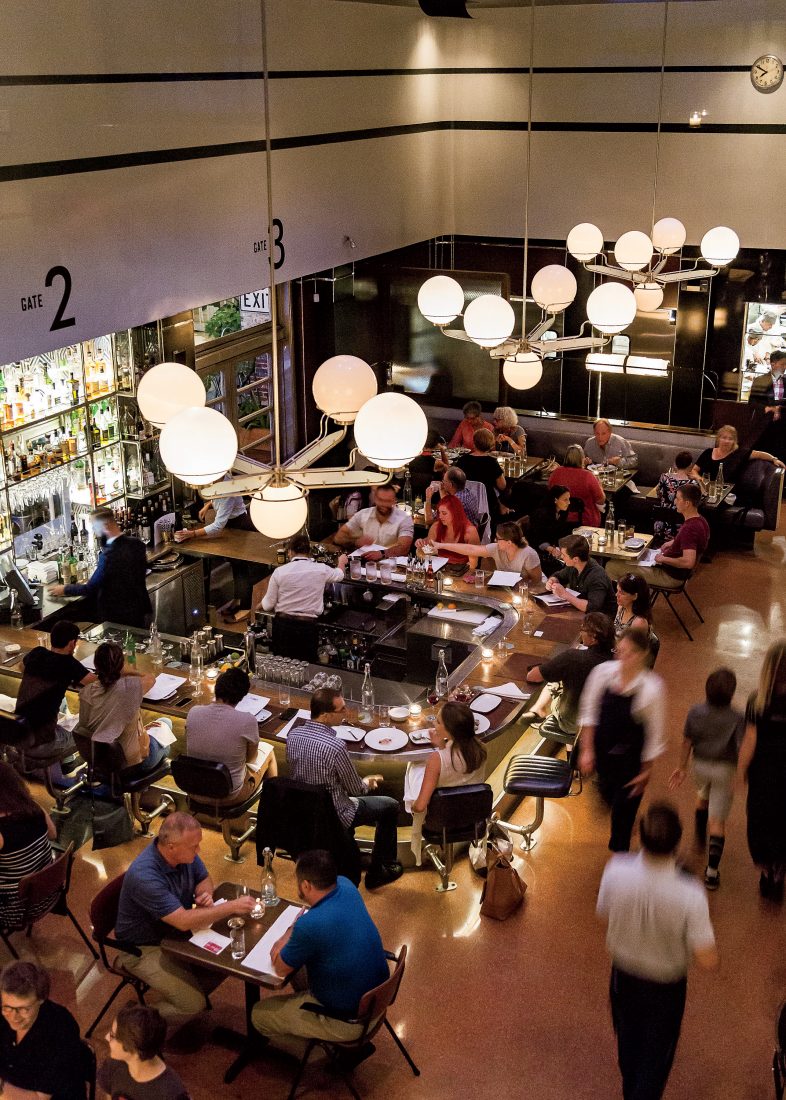
Peter Frank Edwards
Full House
Patrons enjoy dinner.
To discover just what that was, Bailey took a solitary road trip through the South before the Grey opened. She longed to breathe in the air, to
watch the walls of kudzu tick past her open car windows, to reacquaint herself with the rhythms and reason of a place she used to call home. She traveled to Charlotte, Asheville, Knoxville, Jackson, New Orleans, Atlanta, and all points in between, eating in every town, reintroducing her mouth to the flavors of her youth, the sorghum and the salt, the bacon fat and the buttermilk, the vinegar and the blithely blistering sauces.
“I was alone, figuring it out,” she says of the journey. And then, on May 6, 2014, armed with inspiration and context, Bailey pulled into Savannah on what felt like “the hottest day in the world,” and began her new life.
At first the town, one of reflexive culinary (and other) recalcitrance, refused to embrace Bailey with open arms. “There was huge resistance,” she admits. “I wanted to use local people to source my product. I didn’t want to just call some giant company. I had to dig and dig and dig. I wanted to do a pig head, but nobody would sell them to me. I wanted to do eel braised with cabbage and tomatoes and onions and a little spice, but no one was really doing eel here. It was a reality check. I had no support. I’d moved to a state where I knew no one. I was all alone on this island.”
After six weeks of getting nowhere, Bailey recalibrated her approach to suit her new surroundings. “I had to do face time with everybody. I had to be ‘introduced.’ It was such an Old South way of doing business. I had to reassure people, ‘I’m a safe bet, you’ll like me, my money is good, I’m consistent, you can deliver me chickens every week, I’m not going to not be here one day.’” Bailey shrugs. “It was just ‘the way.’”
She was up for the work. She felt the potential in Savannah and was further fueled by deep-seated childhood memories. In the years she’d been absent, she had never forgotten the trees, how come summer the canopy could close out the sky. Or the wet heat and the cicadas it spawned, whose riotous tymbal song vibrated the air of every square. Or her old family house, a modest Craftsman with a generous screened porch and a towering magnolia that shed its waxy leaves in the backyard where she and her two younger siblings would play, crunching them like parchment beneath their feet. Bailey remembered all of that and more—the drums of the local high school marching band practicing nearby, the unlined faces of her parents, David and Catherine, still young then themselves, the essential, cradling comfort of Southern food.
For Bailey, Savannah is where she remembers being a child, not yet formed or purposeful, just a lovely girl alive in a world of marvels. Back then, Savannah imprinted itself on her. And now it was her turn to imprint on Savannah.
“My other grandmother down south in Waynesboro, my mom’s mom, Geneva West, she would make dinner early and the house would smell like food all day,” Bailey reminisces. “She had nine kids and they were dirt poor, but she was a hell of a cook. She could put a stick in a pot and it would be delicious.”
When Geneva passed away, mourners at her funeral told stories about how she made everything from scratch, how you could always find something sweet at her house. A pie on the table. A cake on top of the fridge. Her culinary generosity had become her legacy, a path that speaks to Bailey for myriad reasons.
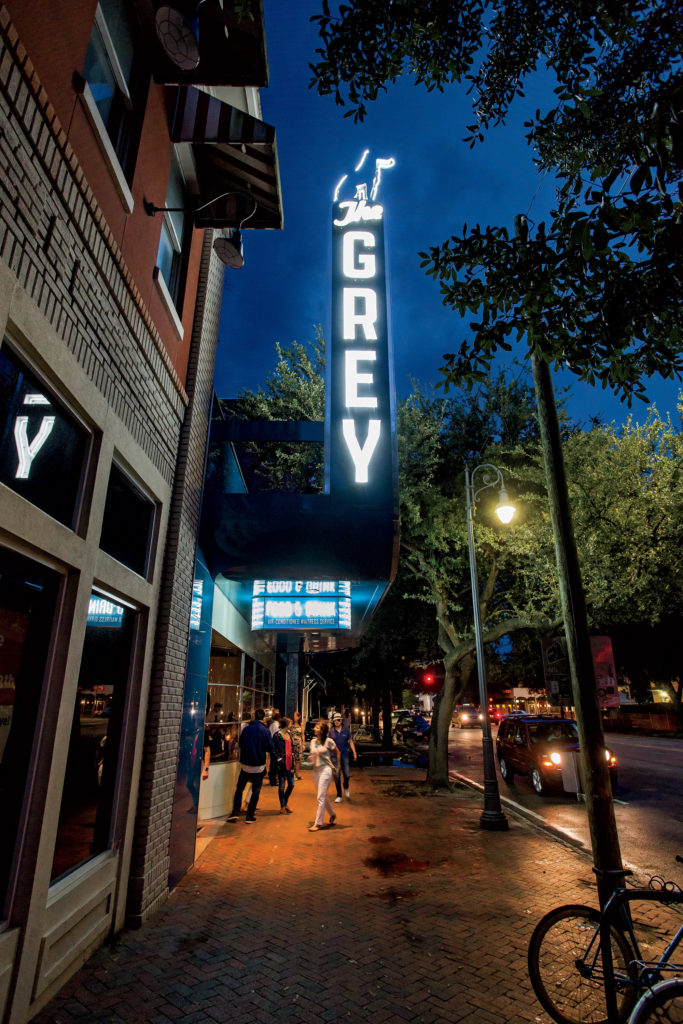
Peter Frank Edwards
The Grey lights up the night.
Bailey has already been approached, she says, about expanding her nascent brand. But she has thus far demurred. Like her current hometown, she wants to take things slow. “I’m still the new kid on the block in so many ways,” she says, smiling. “Right now I just want everything to be wonderful at the Grey.”
It is there—in that context, with her cuisine—where Bailey believes herself strong enough to upend how things were in favor of how things could and should be. History cannot be rewritten. But Bailey knows the value of a righting footnote. “I want people to come to the restaurant and feel comforted,” she says. “That’s what it’s all about. Leaving with a full belly and that feeling of home.”


